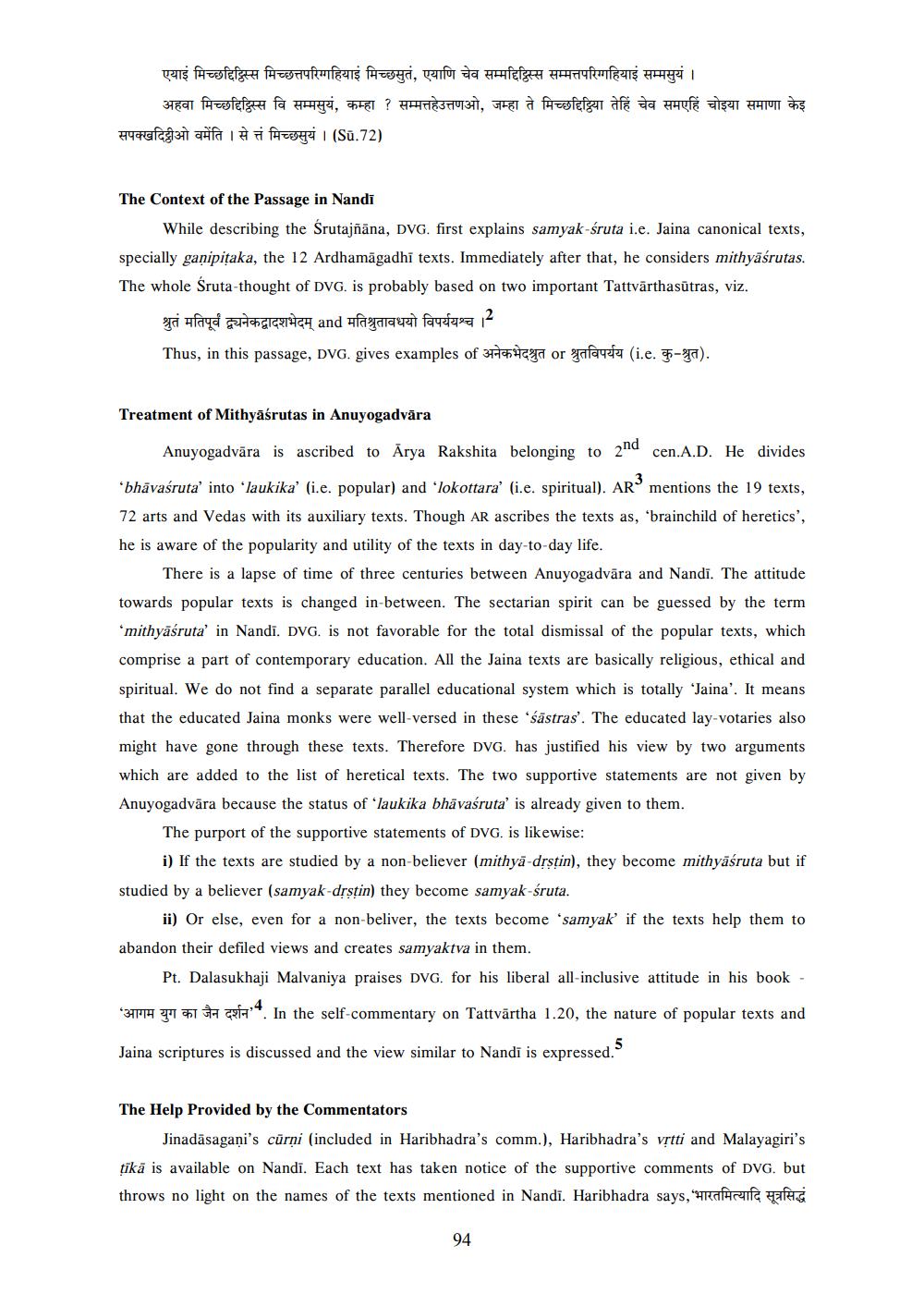________________
एयाई मिच्छद्दिट्ठिस्स मिच्छत्तपरिग्गहियाई मिच्छसुतं, एयाणि चेव सम्मद्दिहिस्स सम्मत्तपरिग्गहियाई सम्मसुयं ।
अहवा मिच्छद्दिट्ठिस्स वि सम्मसुयं, कम्हा ? सम्मत्तहेउत्तणओ, जम्हा ते मिच्छद्दिठ्ठिया तेहिं चेव समएहिं चोइया समाणा केइ 494ec931 aufa fundi (Sū.72)
The Context of the Passage in Nandi
While describing the Srutajñāna, DVG. first explains samyak-śruta i.e. Jaina canonical texts, specially ganipitaka, the 12 Ardhamāgadhi texts. Immediately after that, he considers mithyāśrutas. The whole Sruta-thought of DVG. is probably based on two important Tattvārthasūtras, viz.
श्रुतं मतिपूर्वं ट्यनेकद्वादशभेदम् and मतिश्रुतावधयो विपर्ययश्च । Thus, in this passage, DVG. gives examples of 31ATA or gafauzfa (i.e. 15-ja).
Treatment of Mithyāśrutas in Anuyogadvära
Anuyogadvāra is ascribed to Ārya Rakshita belonging to 2nd cen.A.D. He divides 'bhāvašruta into 'laukika' i.e. popular) and 'lokottara' (i.e. spiritual). AR' mentions the 19 texts, 72 arts and Vedas with its auxiliary texts. Though AR ascribes the texts as, 'brainchild of heretics', he is aware of the popularity and utility of the texts in day-to-day life.
There is a lapse of time of three centuries between Anuyogadvāra and Nandi. The attitude towards popular texts is changed in-between. The sectarian spirit can be guessed by the term *mithyāśruta' in Nandi. DVG. is not favorable for the total dismissal of the popular texts, which comprise a part of contemporary education. All the Jaina texts are basically religious, ethical and spiritual. We do not find a separate parallel educational system which is totally 'Jaina'. It means that the educated Jaina monks were well-versed in these 'śāstras'. The educated lay-votaries also might have gone through these texts. Therefore DVG. has justified his view by two arguments which are added to the list of heretical texts. The two supportive statements are not given by Anuyogadvāra because the status of 'laukika bhāvasruta' is already given to them.
The purport of the supportive statements of DVG, is likewise:
i) If the texts are studied by a non-believer (mithya-drstin), they become mithyāśruta but if studied by a believer (samyak-drstin) they become samyak-śruta.
ii) Or else, even for a non-beliver, the texts become 'samyak' if the texts help them to abandon their defiled views and creates samyaktva in them.
Pt. Dalasukhaji Malvaniya praises DVG. for his liberal all-inclusive attitude in his book -
*31114
$
f. In the self-commentary on Tattvārtha 1.20, the nature of popular texts and
Jaina scriptures is discussed and the view similar to Nandi is expressed."
The Help Provided by the Commentators
Jinadāsagani's cūrņi (included in Haribhadra's comm.), Haribhadra's vịtti and Malayagiri's tikā is available on Nandi. Each text has taken notice of the supportive comments of DVG. but throws no light on the names of the texts mentioned in Nandi. Haribhadra says, "Hraftril EHS
94




